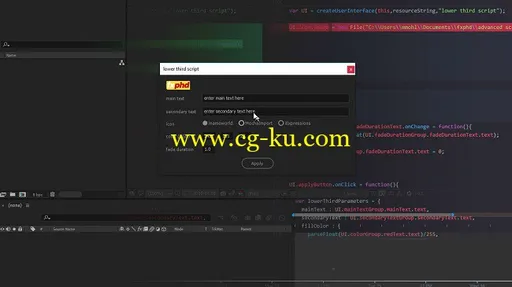
8 Classes Project Files Included MP4
Title: FXPHD – AFX303 Advanced Scripting for After Effects, Part 1
Info:
You already have some experience with scripting in After Effects (or attended the Beginner Scripting Course AFX226)? Then this course will take your scripting work to the next level! In the course, scripting expert Mathias Möhl will focus on three aspects: scripting tools, clean code and hands-on examples.
# Scripting Tools #
Learn how to use the distributed version control system git that turns your code into a time machine in which you can track changes, access previous version of your code and collaborate with other team members. Also, learn how to configure the Atom text editor for After Effects scripting to turn it into a very powerful alternative for ExtendScript Toolkit. The best of it: Both git and Atom are not just highly professional software development tools, but also available free.
# Clean Code #
The larger your scripting projects become, the more important it is to write clean code, that consists of independent, modular and reusable code blocks. In this course you learn how to write such clean code and how to create your own library of reusable code snippets. To achieve this goal, you also learn how to use functions effectively and how to use the Module and Constructor patterns.
# Hands-on Example #
All the concepts mentioned above are explained based on hands-on After Effects scripting examples. You learn, for example, how to embed images for the user interface of a script directly in the code and how to read data from a spreadsheet.
course syllabus
CLASS 1
We start by configuring the Atom text editor for After Effects scripting. We configure Atom such that it does proper syntax highlight for jsx files and configure a keyboard shortcut that executes the After Effect script directly from inside Atom. Also, you get a first overview of the git version control system.
CLASS 2
Here you get some first practical experience with git and learn how to access previous versions of your scripting code with it. You also learn how to add icon buttons to the user interface of a script.
CLASS 3
In this class Mathias explains how to embed binary files – like the images of icon buttons – directly in your code. You also learn how to make your code more modular by using functions effectively.
CLASS 4
In this class we cover how to use the embedded binary data we created in the previous class. You also learn how to use tags in git to label important points in time in your development. Furthermore, you learn how to use exceptions in JavaScript to do proper error handling.
CLASS 5
Time to cleanup your code: Today we cover the Module pattern which is a key concept for modular and reusable code. You also learn how to execute command line calls from a script, how to open an URL in the default browser and how to create snippets in Atom.
CLASS 6
Reading data from a spreadsheet is useful in many scenarios where After Effects should be used in an automated way. In this class we start writing a function that reads data from a spreadsheet. We also cover a good habit how to deal with optional arguments of functions.
CLASS 7
In this class we finish the spreadsheet parser we started in the previous class. You also gain some hands-on experience in debugging your code with ExtendScript Toolkit.
CLASS 8
In this class we cover the Constructor pattern which allows you to create objects in the spirit of Object Oriented Languages like Java or C++. Like the Module pattern, this is a key concept for clean, reusable code.
8类项目文件包括 MP4
标题: FXPHD – AFX303 高级脚本后效果, 1 部分
信息:
您已经有一些脚本的经验, 在效果 (或参加初学者脚本课程 AFX226)?然后, 本课程将把您的脚本工作带到下一个级别!在本课程中, 脚本专家 Möhl 将重点介绍三方面: 脚本工具、干净代码和实际示例。
# 脚本工具 #
了解如何使用分布式版本控制系统 git 将您的代码转换为可跟踪更改的时间机器, 访问以前版本的代码并与其他团队成员协作。此外, 还要了解如何将 atom 文本编辑器配置为在效果脚本之后, 将其转换为 ExtendScript 工具包的一种非常强大的替代方法。最好的是: git 和 atom 不仅是高度专业的软件开发工具, 而且还可以免费使用。
# 干净的代码 #
脚本项目越大, 编写干净的代码就越重要, 它由独立的、模块化的和可重用的代码块组成。在本课程中, 您将学习如何编写这样干净的代码, 以及如何创建自己的可重用代码段库。为了实现这一目标, 您还将学习如何有效地使用函数以及如何使用模块和构造函数模式。
# 动手示例 #
上面提到的所有概念都是根据效果脚本示例的实际操作来解释的。例如, 您将了解如何在代码中直接为脚本的用户界面嵌入图像, 以及如何从电子表格中读取数据。
课程提纲
1班
我们首先配置 atom 文本编辑器后效果脚本。我们配置 atom, 使其对 jsx 文件进行适当的语法高亮, 并配置一个键盘快捷键, 直接从 atom 内部执行效果脚本。此外, 您还可以得到 git 版本控制系统的第一个概述。
2班
在这里, 您得到了一些 git 的第一个实际经验, 并学习如何使用它访问您的脚本代码的早期版本。您还将了解如何将图标按钮添加到脚本的用户界面中。
3班
在这个类中, "马赛" 解释了如何在代码中直接嵌入二进制文件 (如图标按钮的图像)。您还将学习如何通过有效地使用函数使代码更加模块化。
4班
在这个类中, 我们介绍了如何使用我们在上一个类中创建的嵌入式二进制数据。您还将学习如何在 git 中使用标签来标记您的开发中的重要时间点。此外, 您还将学习如何在 javascript 中使用异常来执行正确的错误处理。
5班
清理代码的时间: 今天我们介绍模块模式, 它是模块化和可重用代码的关键概念。您还将了解如何从脚本执行命令行调用、如何在默认浏览器中打开 url 以及如何在 atom 中创建代码段。
6班
从电子表格中读取数据在许多情况下都很有用, 在这些情形中, 应以自动方式使用效果。在这个类中, 我们开始编写一个从电子表格中读取数据的函数。我们还包括一个好习惯如何处理可选的功能参数。
7班
在这个类中, 我们完成了我们在上一个类中开始的电子表格分析器。您还可以通过 ExtendScript 工具箱在调试代码方面获得一些实际经验。
8班
在这个类中, 我们涵盖了构造函数模式, 它允许您以面向对象的语言 (如 java 或 c++) 的精神创建对象。与模块模式一样, 这是干净、可重用代码的一个关键概念。